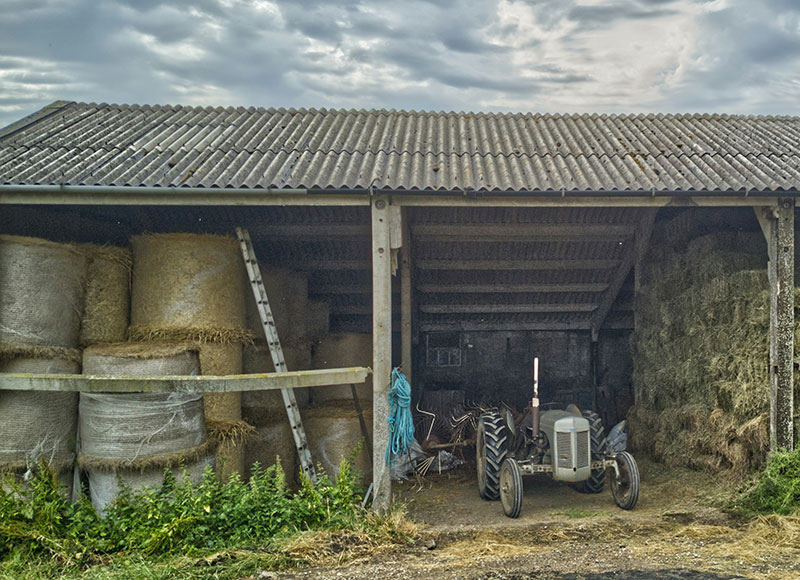Asbestos on farms: what you need to know to stay safe and compliant
When many people think of the now-banned, and notoriously carcinogenic, mineral known as asbestos, they are not necessarily immediately put in mind of farm buildings. Asbestos is, however, present in a wide range of farm buildings and structures even in the UK of the 2020s, which reflects how extensively asbestos was used through much of the 20th century.
It took a while during that century for the extremely serious health risks presented by asbestos to become fully and widely understood. Today, however, it is very much understood that asbestos-related health conditions, such as mesothelioma and asbestos-related lung cancer, are responsible for around 5,000 deaths a year in the UK.
It is of critical importance, then, for farm owners and tenants to be aware of where asbestos-containing materials (ACMs) might be present on a farm, as well as what steps they might need to take to manage asbestos risks. This will be vital if the health of those working in the agricultural industry to be protected not just now, but for generations to come.

Why is asbestos a concern on farms?
A final ban on the importation and use of all forms of asbestos in the UK was only finally handed down in 1999, following the outlawing of crocidolite (blue) and amosite (brown) asbestos in 1985. Until that point, however, asbestos had been extremely widely used in UK construction and other sectors, valued for such qualities as its relative affordability, availability, physical strength, and fire resistance.
A significant proportion of today’s farm buildings were constructed during a time when asbestos was a commonly accepted building material. Indeed, such was the substance’s reputation as a “wonder material”, there is a strong chance of any given farm buildings, equipment, and/or infrastructure built or installed before the late 20th century still containing some degree of asbestos.
However, it became much more widely known as the 20th century wore on, that an individual inhaling or swallowing asbestos fibres could heighten their risk of developing a potentially fatal asbestos-related disease – such as mesothelioma, asbestosis, or lung cancer – in later life.
This underscores the importance of farm owners and tenants doing everything they reasonably can to prevent new instances of asbestos exposure on their sites.
Where might asbestos be found on farms?
Such was the popularity and perceived versatility of asbestos during its peak period of use, the substance may be found in a very wide range of locations on farms. Old barns, sheds, machinery housing, and insulation materials, as well as waste material buried in the soil, are all examples of places and products where the now-banned mineral might be present.
Of course, the situation can vary greatly from one farm to another. In the case of your site, the material might only be present in the asbestos cement roof of a shed, and perhaps in asbestos rainwater gutters. On some farms, however, asbestos may be extensive.
Some of the ACMs that you find at your farm might be relatively obvious, akin to those present in many other types of 20th-century commercial properties – think such products as ceiling or wall panels and insulation. However, there are also some less well-known potential sources of asbestos exposure, such as certain types of linings, gaskets, and roofing materials.
How can you identify asbestos on your farm?
According to UK Government advice, it is chrysotile asbestos – also known as “white asbestos” – that is the most common type found on farms, although six types of asbestos exist. This can complicate the task of trying to spot asbestos by sight alone; pipe or boiler insulation, for example, may comprise a mix of blue, brown, and white asbestos.
White asbestos is light grey in colour, and if you see flaking or powdering on a damaged or worn surface, this might be an indicator of the given material containing asbestos. It also helps to know some of the classic locations where asbestos may be spotted, such as in rainwater pipes and gutters, in corrugated roofing and cladding, and in panels between wallboards.
The reality, however, is that it can be notoriously difficult to identify suspected ACMs purely by visual inspection. This – combined with the legal duty to manage asbestos in all “non-domestic” properties, as set out by the Control of Asbestos Regulations 2012 (CAR 2012) – underlines the importance of having a professional assessment carried out.
The first step of managing asbestos on a farm is to arrange the professional survey that will allow for all on-site ACMs to be located and assessed. The basic survey – for ongoing maintenance – is known as an asbestos management survey.
If, meanwhile, you expect to carry out significant refurbishment or demolition works at a given farm building, you will need to arrange for a refurbishment or demolition survey, which is more intrusive than a management survey.
What should you do if you find asbestos on your farm?
Presuming you have had one of the aforementioned types of survey carried out, and asbestos has been confirmed to be present on your farm, your exact actions will largely depend on the specific circumstances and nature of the risk.
Nonetheless, CAR 2012 outlines a “duty to manage” asbestos, with certain steps that need to be taken to manage asbestos risks. If you are a “dutyholder” under this legislation – for example, because you are a person or organisation with clear responsibility for a given farm building’s maintenance and repair – you will need to put together a detailed asbestos management plan. This document should set out how the asbestos risk will be managed.
ACMs are believed to pose negligible health risk if they are in good condition, undisturbed, and unlikely to be disturbed in the future. Unfortunately, however, this won’t necessarily be the case for certain ACMs on a farm – for example, asbestos-clad roofing that may have sustained damage in previous instances of bad weather.
If, then, you discover materials that are suspected or confirmed to be asbestos, you may need to secure the area temporarily to minimise the likelihood of future disturbance, and so that you can make decisions on how to manage the material going forward.
By contacting a licensed asbestos professional, you will be able to ensure you receive the best possible assessment and advice. It may be possible to leave the substance in place and to monitor and manage it over time, or – if the ACMs pose a particular risk – you might need to arrange for them to be removed by a licensed contractor.
How is asbestos safely removed from farm properties and disposed of?
One of the reasons to arrange for a licensed professional to carry out any removal of asbestos from your farm, instead of attempting to do so yourself, is because they will be extensively trained in safe asbestos removal practices.
Those practices encompass such vital and specialised measures as putting in place effective containment and air filtration, as well as knowing how to dispose of asbestos in a safe and legally compliant manner. The latter will include double-wrapping ACMs in heavy-duty plastic bags that don’t rip, as well as properly labelling bags to make clear they contain hazardous substances. ACMs must also be left in one piece for disposal, instead of being broken up.
The wearing of personal protective equipment (PPE) is also essential for anyone working with asbestos. PPE encompasses such items as disposable clothing and respiratory protective equipment (RPE).
It may be legally permissible for some asbestos removal projects to be carried out by a contractor who is merely competent, but not necessarily licensed. If, however, there is a need to work with asbestos board, insulation, or sprayed coatings, it will be legally necessary for this to be undertaken by a licensed contractor.
Some farmers may be tempted, as an alternative to proper disposal, to simply bury asbestos on their land. However, as we have written about in the past, this could bring major health, safety, legal, and other problems.
Buried asbestos is still asbestos that could be disturbed in the future, depending on how the land is used over the weeks, months, and years ahead. Furthermore, the UK prohibits the burying of asbestos waste, which means you could be heavily fined and/or imprisoned if you ignore this regulation.
What are the legal obligations for managing asbestos on farms?
CAR 2012 sets out various obligations that dutyholders have in relation to asbestos at non-domestic premises, including on farms. These obligations typically apply to all farm buildings except the house, which does not normally need to be included.
For the other farm buildings, however, the legal obligations for farm owners and managers include (but are not limited to):
- Taking reasonable steps to determine whether there are ACMs in the given building, which can be done by means of a survey by a competent surveyor
- Determining – if asbestos does turn out to be present – where the ACMs are, and what condition they are in
- Presuming that materials do contain asbestos, unless there is strong evidence of this not being the case
- Devising an in-depth asbestos management plan setting out how the risks will be managed
- Putting the plan into action
- Reviewing the asbestos management plan at least annually.
What funding or support is available for asbestos management on farms?
As we touched on previously in our guide to grants for the removal of asbestos roofs, it may be difficult to find sources of funding or support for asbestos management on your farm.
If, for example, you are seeking grants to pay for asbestos removal, it might be better to look on a local basis, rather than a national one. Your local authority may make available grants or other forms of financial assistance.
If the property where you will be carrying out asbestos-related work is of historical or architectural significance, it might also be worth checking for heritage grants from organisations such as the National Lottery Heritage Fund or Historic England.
We have also previously written about tax relief as a potential source of support for those looking to carry out asbestos removal or remediation work. Since 2001, businesses – such as farms – have been entitled to a 150% tax rebate for expenditure on land remediation, which includes asbestos.
Conclusion: asbestos on farms presents risks that require careful management
While farms aren’t necessarily often talked about as a source of asbestos risks, the reality is that those risks can be very real, especially given that many farm buildings date from prior to the 1999 ban on asbestos in the UK. This underlines the importance of farm owners and managers taking steps to safely and responsibly manage, and potentially remove, asbestos on their sites.
Here at Oracle Solutions, we would always urge farmers and agricultural workers to prioritise health and safety by staying informed, conducting relevant assessments, and seeking professional help when dealing with asbestos.
To request a free and fast quote from us today, please feel free to send us an email or to give the Oracle team a call.

Written by Callum McDonald
Callum McDonald is an expert in asbestos quality management, ensuring rigorous adherence to regulations and high-quality standards in removal projects. His focus on enhancing quality and client satisfaction makes him a crucial asset in safety and compliance within the field. Callum's expertise in technical support and oversight of licensed works underscores his commitment to excellence in asbestos management, providing invaluable guidance to clients in this specialised area.

